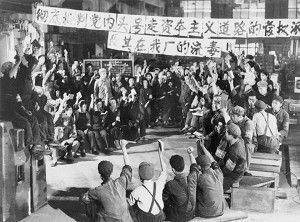On the 40th anniversary of the Cultural Revolution, which still has a strong impact on today’s Chinese people, our reporter visited the first Cultural Revolution Museum in Shantou City, an industrial port in the northeastern corner of Guangdong Province. The private Cultural Revolution Museum is founded by Peng Qian, a former Shantou deputy mayor.
The museum was constructed on top of Tashan Hill in Shantou’s Chenghai District. Why was this first Cultural Revolution Museum built on an unknown hill in southern China? The local motorcycle transport owner explained that many people died here during the fierce violence of the Cultural Revolution.
A motor driver said, “The fighting went on and on. All those names listed on the tombs were killed in violent clashes. It was called the ‘fighting by force’. At that time, those who were dragged out by officials to be criticized and denounced, were then shot to death.”
The reporter asked, “Have you witnessed people fighting people?”
The motorcyclist said, “Yes. There was nothing but fighting among the different groups.”
The reporter then asked, “Were there people killed in the fighting?”
The motorcyclist responded, “Yes. In fact there were many.”
It has been recorded that during the Cultural Revolution as many as 100,000 local people were implicated, more than 4,500 people were injured or disabled, and over 400 were killed including 70 identified. The victims were buried namelessly on the Tashan hillside. On his way up the hillside, the reporter saw tombs of all sizes, one of them is a mass grave holding 28 bodies.
Mr. Peng Qian, who was himself persecuted by Red Guards during the Cultural Revolution, saw these unmarked burial mounds in 1996, and later contacted many officials and others with painful memories of the Cultural Revolution He was the main driving force in establishing a museum in commemoration of those who died during the Cultural Revolution.
Ten years of efforts have seen more than ten sites built, including Shijianshanwu (House on the Hill to Review History), Jingzhongchangming (Alarm Bell Rings Constantly), Shibishushi (Stone Pen Recording History) and Baotasian (Pagoda Meditation and Peace).
The Shijianshanwu is a building 21 meters in height, imitating the Temple of Heaven in Beijing. The black engravings on its walls reflect one of the darkest chapters of recent Chinese history. The model for these engravings come from a 1995 large picture album called ‘Cultural Revolution Museum’, published by Yang Kelin in Hong Kong.
The picture book depicts the origin of the Cultural Revolution, Mao (Founder of the People’s Republic of China) worship, the mass criticism, seizing of power, and many other things.
The reporter ran into a group of young people who had just finished visiting the exhibition.
The reporter asked, “Do you think it’s meaningful to build a Cultural Revolution Museum now?”
One of the young people replied, “Yes, certainly! I think this museum should be expanded and the spreading of its exhibition content should be further promoted. This is really good, but many people don’t know of this museum.
“How did you know about this?” asked the reporter.
“We found it on the Internet, then we came here to see this museum.” the young people replied.
“What’s the most impressive thing you saw?” asked the reporter
The young people said, “Since our generation has no impressions or memories of the Cultural Revolution, this is our first time seeing something like this.”
The reporter asked a staff member from the administrative office of the Tashan museum, “Do you think this museum serves an educational purpose?”
The staff member replied, “Whether this exhibit serves an educational purpose or not depends on visitors. If you think it is of education nature, then it is. If you think it isn’t instructive, then it isn’t. It’s all up to visitors’ own reflection. Because you spend 5 yuan (US$0.625) for this thing, it does matter what feeling you get when you see it.”
The reporter met an official at the bottom of Tashan Hill. The official emphasized that one should not just focus on the Cultural Revolution Museum. He said: “We also have a 900-year-old temple here.” Hearing what they said, the reporter could not help thinking that the Beijing authority’s gist of desalting the Cultural Revelation may have not reached this remote hill area in southern China.
(Complied from the Radio Free Asia recording)

Friends Read Free